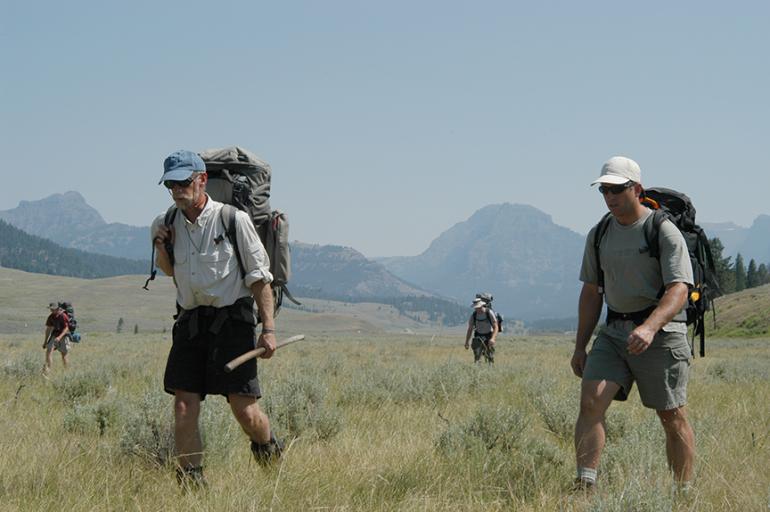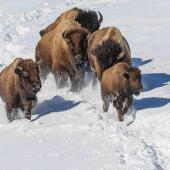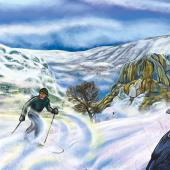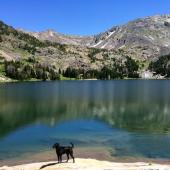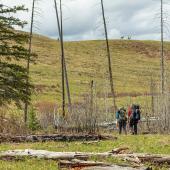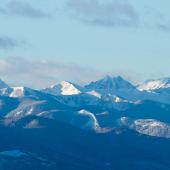Backcountry Yellowstone
I wake, shove down my sleeping bag, and pull on my shirt and shorts. Unzipping the tent, I crawl to the door and peer out. It's damp and still following the night's drizzle.
I pull on a fleece jacket and snug on my boots. Stove, pot, water, coffee, and I line up everyone's mug. While the water's on I grab my binoculars and walk to a ridge twenty yards above the tents. The campsite is in a stand of trees on the edge of a broad meadow and from my low ridge I can see down its entire length. I scan for elk and moose, bison and bear, and whatever else is possible in the wildlife realm of Yellowstone National Park.
Three hundred yards down the meadow a big bull elk is grazing along the forest edge. As I watch, a second, and then a third appear. All three are chowing down; all three are mature bulls with substantial velvet-covered antlers, dark necks, tan bodies, and sagging dark bellies. I've watched lots of elk, but to be immersed in the same landscape with them somehow gives the experience greater validity. These aren't any roadside elk; in fact, we're two days and 18 miles into Yellowstone's northwest corner, and the passage of distance and time makes me appreciative and grateful to be here.
I glance back toward the stove, then toward the tents, still no one stirring and I hope my cohorts are up to see these guys before they head back into the trees to bed. The water's boiling so I prod them with coffee, and, speaking in hushed tones, we hustle to the ridge just in time to catch a glimpse of the big bulls melding into the forest. As we watch, their bodies blend with the shadows and their antlers with the trees.
Hiking, wildlife watching, and fishing are great anytime, but I enjoy them all the more if I'm on a long backpack trip. I like the simplicity of it. All my gear, everything I need for a full week in the Yellowstone backcountry, is with me. No livestock to tend, no large groups of people, none of the saddling, packing, and unpacking that stock parties seem to spend so much time on. There's no doubt, the simplest, least expensive, most independent, and most self-rewarding backcountry experience accompanies those who simply shoulder a backpack stuffed with necessities (and a few lightweight luxuries), plan a route, and start walking.
There's a reason so many schools and youth education programs have backcountry-based components. Being totally enveloped in pristine natural surroundings promotes true re-creation and self-discovery. When you're deep in wilderness you have to rely on your own physical capabilities, knowledge, skill, and planning to provide for your health, security, and pleasure. Equally important, these qualities help you minimize your impact on the landscape. This self-reliance, and ultimate self-confidence, are two of the greatest rewards of the multiday backcountry trek. Besides that, it's fun, healthy, and immensely beautiful.
There are distinct advantages to backpacking in Yellowstone. The diverse array of elevations, terrain, and habitats makes for incredible trip options. A person could literally spend a lifetime exploring the Yellowstone and adjacent national forest backcountry. There are other advantages as well. Because campers are required to reserve and camp in specific, and limited, sites, the campsites and trails never get crowded. Safe food storage is facilitated by the presence of food-hanging poles ready for use. Since hunting isn't allowed, wildlife is often somewhat acclimated to human presence. Of course, the total lack of motorized trail traffic fits the backpacking atmosphere perfectly.
After all, I do this for a nature-based experience. For years I would hear people speak of Yellowstone regions, trails, and rivers with respect and reverence; names like Bechler, Black Canyon, or Thorofare would roll through the air and I could only imagine their features and significance. Over time I would sidle up to folks and casually ask their favorite trails and seasons to explore these places. After perusing maps and reading guidebooks (another great characteristic of Yellowstone is that there's a wealth of literature available on all aspects of the park), I was able to create my own itineraries.
Slough Creek
Renowned for its pristine meadows and native cutthroat fishery, Slough Creek has become very popular with outfitted fishing groups. Make campsite reservations early. The large valley floor meadows and mountain slopes are also great for wildlife. Trails connect with the rugged Absaroka Range to the north. The Hellroaring Creek drainage further west is also a great option, as is Pebble Creek to the east.
Thorofare
Thorofare Creek joins the Yellowstone River in the remote southeast corner of the park. It drains a region outside Yellowstone (Thorofare Plateau) which is one of the great roadless areas of the lower 48 states. If you want to go really deep into the backcountry of Yellowstone, this is a good one: huge valleys, great scenery, excellent wildlife potential, fishing, and the opportunity to see how strong your legs really are. The Thorofare Trail roughly follows Yellowstone Lake shoreline and connects with the Snake River Trail to create a large loop.
Shoshone Lake
This is one of the most popular backcountry thermal areas (Shoshone Geyser Basin) and is also canoe accessible from Lewis Lake. The lake itself is huge and presents good fishing and wildlife (primarily birds) opportunities. Heart Lake is another remote, and popular, backcountry thermal area.
Bechler
Bechler River drains the southwest corner of Yellowstone. It’s often referred to as "Cascade Corner" due to the numerous regional waterfalls descending from the Madison Plateau. You'll probably see some of these waterfalls in the distance as you cross pristine and lush meadows which enclose meandering stream channels.
Black Canyon
The Black Canyon of the Yellowstone River is a beautiful canyon enclosing a beautiful river. You'll feel like you're in A River Runs Through It only the river is bigger. The scale of the river and canyon helps define humility among humanity. Even though you're inside the canyon for much of the hike, there are incredible scenic views and you've good opportunities for eagles, otter, and other river wildlife.
Sky Rim Trail
This trail is in the northwest corner of Yellowstone among high peaks and alpine lakes. It’s great scenic and wildlife country, which contrasts with the river-based hikes mentioned above. The trail follows dramatic alpine terrain and still affords the option of stream and lake fishing, along with excellent wildlife possibilities. The panoramic views are stupendous, and the access trails traverse mosaics of meadow and forest.


